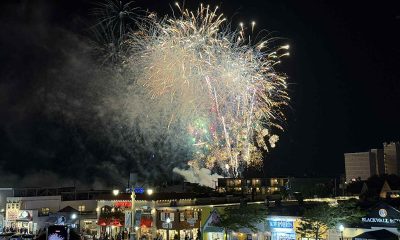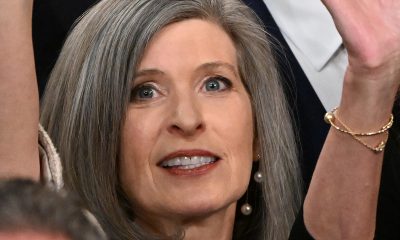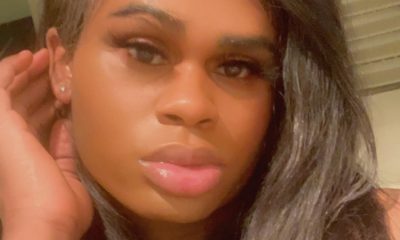a&e features
D.C.’s queer nightlife scene thriving, bucking national trends
Deep Cvnt, Crush, other bars and events keep city venues bustling

John Etienne is familiar with the drifting sounds from vodka-fueled conversations and the tapping of feet against the floorboards of Trade, a gay bar in D.C.’s Logan Circle. On any other Thursday night, Etienne — a party host, judge, and queer nightlife socialite — would be up on the dance floor, sipping a gin and ginger ale, dancing to the new Beyonce song with friends.
But this is not just any Thursday.
Tonight he is sitting directly beneath the dance floor in a salon chair, adjusting his sparkly green dress and white go-go boots, flipping between checking his phone and looking at the clock, waiting for the other judges to arrive. It is just after 9 p.m. and Deep Cvnt is about to begin.
Deep Cvnt is a “mini ball deluxe-inspired party.” Etienne hosts the event once a month at Trade where queer people from across the city come to walk down a runway in categories, show off their best outfits to an established theme, and ‘vogue the house down’ making the “dive bar with a dance floor” feel like the set of a 2024 Paris is Burning. The party’s name is based on a slur, reclaimed into a symbol of feminine and queer empowerment.
During the day, the 25-year-old works as a Digital Fundraising Director for the House Majority PAC. To him, gay bars that host events are instrumental in fostering a feeling of welcome and belonging for those who identify as LGBTQ.
“[For me] It’s the sense of community,” Etienne said. “ I think that being able to go to a spot where there are people who are like me, in some shape or form being that they’re queer or from a marginalized community, and can find refuge in these spots is something that’s incredibly important. And then, too, I think that these [queer] spaces are just a lot more fun.”
Historically gay bars have acted as places for the LGBTQ community to gather, celebrate, and mobilize for political causes when the general attitude was more hostile to the community. D.C.’s unique queer nightlife scene sets it apart from other major gay hubs, like New York or San Francisco, due to the city’s number of welcoming spaces, its business appeal, and the strong presence of the federal government in its culture, allowing for the country’s capital city to be a statistical anomaly.
Nationwide, gay bars have been on the decline since the 1980s. Damron’s Travel Guide, a database that has been recording the locations and ratings of queer/gay bars since the 1960s, found that in the year 1980 there were approximately 1,432 gay bars across the United States. A recent study published in the National Library of Medicine found that the number of gay bars in the U.S. has nearly been cut in half, with only 803 queer-identified bars in existence despite increasing numbers of public support for the LGBTQ community.
This trend is occurring at the same time as a record number of anti-LGBTQ legislation is popping up in state legislatures across the U.S. According to the American Civil Liberties Union, more than 500 anti-LGBTQ bills have been introduced so far in 2024. These laws restrict the ability of transgender Americans to get gender-affirming care, force teachers to out their students to parents, and ban First Amendment-protected actions like performing in drag, among other issues.
Meanwhile the number of bars that cater to the LGBTQ community in the nation’s capital has increased from six in 1980 to at least 22 in 2024.
The LGBTQ population is still large in D.C., with some estimates putting the number at just over 66,000. Historically the “gayborhood,” or primary LGBTQ neighborhood was on 17th Street and in the Dupont Circle area. That has changed as numbers have increased over the years, making the whole city feel like the gayborhood.
“Being one of the gayest cities in the world — with one of the gayest per capita populations — that is kind of baked into the fabric of the nightlife economy,” said Salah Czapary, director of the D.C. Mayor’s Office of Nightlife and Culture, when asked about how the LGBTQ community has changed the landscape of the city. “If you look at these certain neighborhoods [17th Street and Dupont], their character has really been defined by the ‘gayborhood’ in the area. That has kind of changed and now you can’t really point to one area as being the sole gayborhood.”
Then the COVID-19 pandemic happened, causing the government to pause all non-essential businesses, including bars. After the pandemic, the growth in the number of gay bars accelerated. “I think that’s kind of just generally after COVID, people are willing to take a risk on something new,” Czapary explained when discussing the impact of the pandemic on the gay bar community.
Ed Bailey, a well-known DJ and co-owner of gay bars Trade and Number Nine, located around the corner from each other in Logan Circle, agrees about the economic opportunities COVID was able to provide but says that gay bar success boils down to the economics of real estate.
“I have a very boring and not very sexy answer to why I think these things happen,” Bailey said when explaining the history of the prominent locations of gay bars in D.C. “At the end of the day, it’s all about real estate. Over time the gay community’s bars, restaurants, and nightclubs that catered specifically to, or were owned by, gay people were in underdeveloped neighborhoods… It wasn’t available to us to be in the high-priced areas. All the clubs and the bars were kind of on the ‘other side of town,’ whatever that meant.”
Bailey said the COVID-19 pandemic helped create a path for the current sprouting of gay bars all over D.C., especially in what are the mainstream, popular areas. “I think luckily the pandemic, at least in D.C., did open up an opportunity for a number of entrepreneurs to say ‘Hey! I have an option here.’ Some of these businesses are looking for people to buy them out or to move in, and so a bunch of people took advantage of that.”
The LGBTQ community has always had a presence in the city. It has been recorded that as early as the 1950s, Washington had become a space recognized for its ability to bring LGBTQ people together.
“I feel like every time I take two steps, I run into another gay person,” Etienne said about living in Logan Circle and the queerness of the city. “I love it. I also think about the nature of what goes on in D.C. Historically, the government has always had a significant number of gay people working for it. Looking back to the Lavender Scare and even before then it’s always been a spot where gay men have either come professionally or personally.”
Mark Meinke, a 76-year-old self-described gay historian founded The Rainbow History Project, an organization that works to “collect, preserve and promote the history and culture of the diverse LGBTQ communities in metropolitan Washington, D.C.” His research supports exactly what Etienne described.
“Between the [19]20s through the [19]60s, most of the gay spaces were owned by straight people,” Meinke said. A consequence of this, he explains, is that there was less of an outward recognition of these spaces as being LGBTQ friendly, keeping the community a secret. “Tolerance comes and tolerance goes,” he said as he explained why the number of accepting spaces increased and decreased during that time.
This fluctuation of accepting bar owners began to change in the 1960s, as places that offered a safe space for LGBTQ people to meet, dance, drink, celebrate, and politically organize became more frequent and owned by more LGBTQ people. Meinke was able to track the increase of acceptance for the LGBTQ community by collecting advertisements from past issues of the Washington Blade (originally called the Gay Blade) from the ‘60s on as more gay-owned or more publicly gay-friendly establishments began to distribute the newspaper. Meinke also tracked additional gay literature in these gay bars, like that of Franklin Kameny’s Mattachine Society literature and their “Gay Is Good” buttons. The literature Kameny distributed was some of the first documented forms of LGBTQ activism in the U.S. and encouraged LGBTQ people to mobilize.
Meinke noticed that during this time, one gay bar called JoAnna’s on Eighth Street in Southeast D.C. became a popular designation for gay people after the owner installed a dance floor.
“In 1968, in Capitol Hill with JoAnna’s, a new social option had emerged for women, one with a dance floor,” Meinke said. In his presentation for the 2002 Washington Historical Conference titled “The Social Geography of Washington, D.C.’s Gay, Lesbian, Bisexual, and Transgendered Community,” Meinke said that the gay community wanted more gay dance floors.
This inspired others in the gayborhood to create more dance spaces. “Johnnie’s (across the street [from JoAnna’s]) saw the future and installed a postage stamp-sized dance floor, and began getting lots of customers…Same-sex dancing in the clubs was perhaps one of the greatest innovations on the social scene in the 1960s,” Meinke wrote.
Not only did the expanding gay bar scene impact who was visiting the city, but the presence of the federal government and the number of universities located in the area also helped attract the gay community, Meinke explained.
As more LGBTQ people moved to D.C. to pursue careers related to the federal government, a backlash was brewing and created a time we now call the McCarthy era. This era, which extended from the early 1950s into the 60s, brought in political repression of left-leaning individuals in D.C.
This repression and eventual prosecution of people based on the fear of communism was led by Wisconsin Sen. Joseph McCarthy and became a major part of the Republican Party’s platform. This fear also heightened political tensions, eventually leading to Republicans accusing homosexuals of espionage. This period was known as the “Lavender Scare.”
Robert Connelly, an adjunct senior professorial lecturer for American University’s Critical Race Gender and Culture Studies Department, explained that this scare was real for many LGBTQ people working in the government. “In [McCarthy’s] mind, homosexuals’ perceived duplicity and emotional instability made them susceptible to foreign espionage and blackmail, you know, which meant that the gays were giving away our secrets,” Connelly said.
This fear prompted the 34th president to take more legal action against the LGBTQ people working in government. “When Eisenhower took office in 1953, one of his first executive orders that he signed was Executive Order 10450,” Connelly explained. “This codified the exclusion of perverts from government employment and thousands of lives were ruined because of this in the early 1950s.” This homophobia eventually led to the firing of thousands of LGBTQ people within the federal government during the ‘50s and ‘60s.
This systematic injustice triggered many LGBTQ people to adapt techniques other marginalized communities were using, mostly inspired by the increasingly successful Civil Rights movement, to politically mobilize and reclaim their power. The homophile movement, one of the earliest precursors to the modern gay rights movement, had major players located in Washington to help push for gay rights. The activism ignited by LGBTQ people during this time endured for decades, addressing a multitude of issues, including anti-war protests and the fight for expanded civil rights.
Some, like Chadd Dowding, 35, a regular patron of gay bars across Washington said that Washington’s gay bar scene has been successful due to the high number of LGBTQ residents and their desire to feel connected to their community.
“I think D.C. has the largest gay population per capita of any city in the country, so that draws a larger audience of queer folks here,” he said. According to the Williams Institute, D.C. still holds the highest percentage in the U.S. “I think there’s also a need for spaces for community, mostly because a lot of people in D.C. are transplants from other parts of the country.”
Others, Like Bombshell Monroe, a drag queen from the House of Mulan (a chosen family, that works to support and mentor queens in Balls and beyond) said that contrarian attitudes are baked into the nature of the city.
As Bombshell slipped on her flower-adorned flared jeans and orange tank top, getting ready to make her first appearance on the dance floor of Trade for Deep Cvnt, matching the spring bling theme of the night, she explained why she felt D.C.’s gay nightlife has been able to grow.
“I feel like D.C. has always been a place of independence and where people, even if we’re not accepted, will fight to be accepted,” Bombshell said while pulling on a fuzzy white and orange bucket hat. “I’m D.C. born and raised and can attest personally. I think that it’s so crazy because it’s political, but it’s not political. I feel like once we get the pushback from other states, we’re the ones that take it and say, ‘Well, bitch! We got something for y’all. You don’t want the gay bars here, we’re gonna put another one here!’”
And put another one they did. Within the past three years, at least six new gay bars have opened up with very different styles and goals. Some bars cater to particular groups within the LGBTQ community, like that of Thurst Lounge on 14th Street N.W., which is a predominantly Black gay space. As You Are Bar, at 500 8th St., S.E., seeks to make an accessible and comfortable space for all in the LGBTQ community, focusing on often overlooked female and non-binary members of the community. Others focus on creating unique nightlife experiences, like that of the craft cocktails in Logan Circle’s Little Gay Pub with its Instagram (and Grindr) famous selfie mirror, or like that of the freshly opened Crush bar, focusing on creating a dance bar for LGBTQ people.
Regardless of the specific reason people visit gay bars, It is clear that they offer platforms to authentically express queer identity in a world that does not always deem this acceptable.
“If we get to a point where we have to start sacrificing more physical spaces for online ones, these spaces could be easily invaded by people who may not have the best intentions,” Etienne said, preparing to head up the scuffed stairs to Beyonce’s Jolene. “There is something very valuable about having a physical space with a physical location because, at the end of the day, that’s what we have fought for.”
As the lights dimmed the Trade dance floor began to hush. A path opened up in front of the stage as the crowd of floral wearing ballroom fans stepped back, accommodating Etienne’s entrance. With the glittery green dress, knee-high go-go boots, and oversized sunglasses it is clear he is in charge of the night.
“Since this is Deep Cvnt I need everyone to raise their hand up,” Etienne said with a smile. “And now put it below your waist. Check how deep your motherfucking cunt is.” The crowd roared with laughter and cheers. “Alright let’s get into it!” Deep Cvnt has begun.
a&e features
From Prohibition to Pride: Queering the District podcast reveals local LGBTQ history
The new podcast explores the hidden history and enduring impact of queer spaces in Washington, D.C.
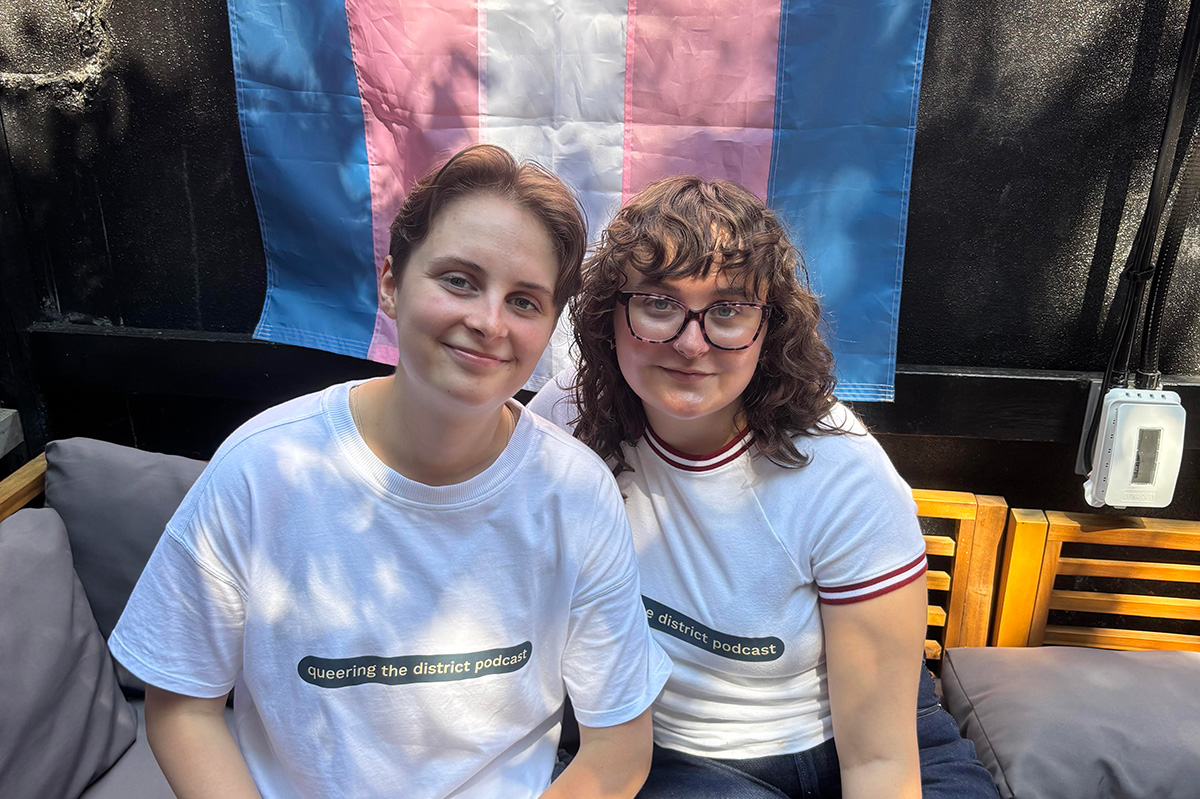
On June 25, as Pride month inched toward its end, three queer creators launched an ambitious project to honor the spaces that built D.C.’s LGBTQ community—and connect them to today’s queer life. The first episode of their podcast, Queering the District, hit streaming platforms that day, aiming to spotlight what host and co-creator Abby Stuckrath calls “third places”: bars, clubs, and gathering spots that have served as hubs for queer life across the city.
Each episode of the 10-part series delves into a different piece of D.C.’s queer past—from landmark clubs to untold personal stories—told through the voices of drag legends, activists, DJs, historians, and patrons who lived it. The show also threads together personal experiences from today’s community, bringing the listener on an auditory journey from Prohibition-era speakeasies to contemporary nights out at places like As You Are or Saints & Sinners.
Abby Stuckrath, alongside her sibling Ellie Stuckrath, and producer Mads Reagan, make up the podcast’s creative team. A recent journalism graduate of American University, Abby told the Blade that her passion for queer storytelling began during college—and that D.C. itself played a defining role in shaping her queer identity.
“I went to American University. I graduated last year and studied journalism. When I was in school, I always wanted to focus on queer stories – especially in D.C., because I’m from Denver, Colorado, I’ve never lived in a place like this before. D.C. has always just kind of been a place I call home when it comes to my queer identity.”
But breaking into the media to tell those stories wasn’t easy. Stuckrath quickly learned that editorial support—and funding—for queer-focused projects is limited. So she decided to do it her own way.
“I kind of found out that if you want to tell stories, you kind of have to do it on your own– especially when it comes to queer stories. There’s not a lot of people begging for us to talk about queer people and to pay you for it. So I was like, ‘Okay, let’s just do it on my own.’”
The idea for the podcast first took root in conversations with Ellie, Abby’s sibling and biggest supporter. Ellie had also moved to D.C. to find more space to explore and express their queer and gender identities. Together, the two began shaping a vision that would combine storytelling, sound design, and grassroots community input.
“I was like, ‘I don’t know what exactly I want to do yet, but I want it to be queer, and I want it to be about D.C., and it’s going to be called Queering the District, and we’re going to find out what that means.’ And Ellie is my biggest supporter, and my best friend. And they were like, ‘Hell yeah. Like, let’s do this.’ And so we decided to just do it together.”
The name stuck—and so did the mission. The team began researching queer D.C. history and found a city overflowing with stories that had rarely been documented, especially in mainstream archives.
“We started looking up the history of queer culture in D.C., and it kind of just clicked from there,” Stuckrath said. “I did not know anything about how rich our history is in the city until one Google search, and then I just kept learning more and more. I was kind of pissed because I studied gender studies in school in D.C. and didn’t learn shit about this.”
Season one focuses on the role of third places—non-work, non-home spaces where queer people could gather, exist fully, and build community.
“Third places have always been the epicenter of queer life… places outside of just your own personal home, because sometimes that isn’t a safe place. And of course, the work most commonly in the past and still today, isn’t a safe place for queer people to be full of themselves. So like, bars were the first place for queer people to really thrive and meet each other.”
To make the show participatory, Queering the District includes a twist: a voicemail line where anyone can call in and share a memory or question. The team calls the phone “Fifi”—a nod to the kind of retro guestbooks often used at weddings, but reimagined for queer nightlife and history.
“We wanted to find a way for people to share their stories with us anonymously… so even though we start in Prohibition, we wanted to connect it to now—like, those people who were singing jazz to each other in a white queer bar are connected to you singing karaoke on a Sunday night at your favorite gay bar. We’re all interconnected by this third place of queer bars in D.C.”
Those connections are emotional as well as historical. While building the series, one realization hit Stuckrath particularly hard: the immense loss of queer spaces in D.C., especially in neighborhoods that have since been heavily redeveloped.
“Every time I go to a Nats game, I think about, well, this just replaced five gay bars that used to be here. It used to be the home of Ziegfeld’s… Tracks, which was almost 2,000 square feet, with a volleyball court in the back, a fire pit, and iconic light show. I just didn’t know that we had that, and it made me sad for the queer elders that are in our city now who walk the streets and don’t see all those places they used to call home.”
That sense of loss—alongside the joy and resilience of queer community—is what the show aims to capture. As the podcast continues, Abby hopes it serves as both a celebration and an educational tool, especially for young LGBTQ people arriving in D.C. without realizing the queer foundations they’re walking on.
“D.C. is a unique city, and specifically young queer people who are hoping to move to the city—to know that you’ve got to know your history to be here. I hope this serves as an easier way for you to consume and learn about queer history, because queer history defines how we move in life.”
And for all the voices still left out, Abby is clear: this podcast is an open door, not a final word.
“This is a perfectly imperfect podcast. We should just be a starting point. We shouldn’t be the ending point.”
New episodes of Queering the District drop every Wednesday on all major platforms.
a&e features
Doug Spearman takes his chance
‘Noah’s Arc: The Movie’ debuted on Paramount+ last month
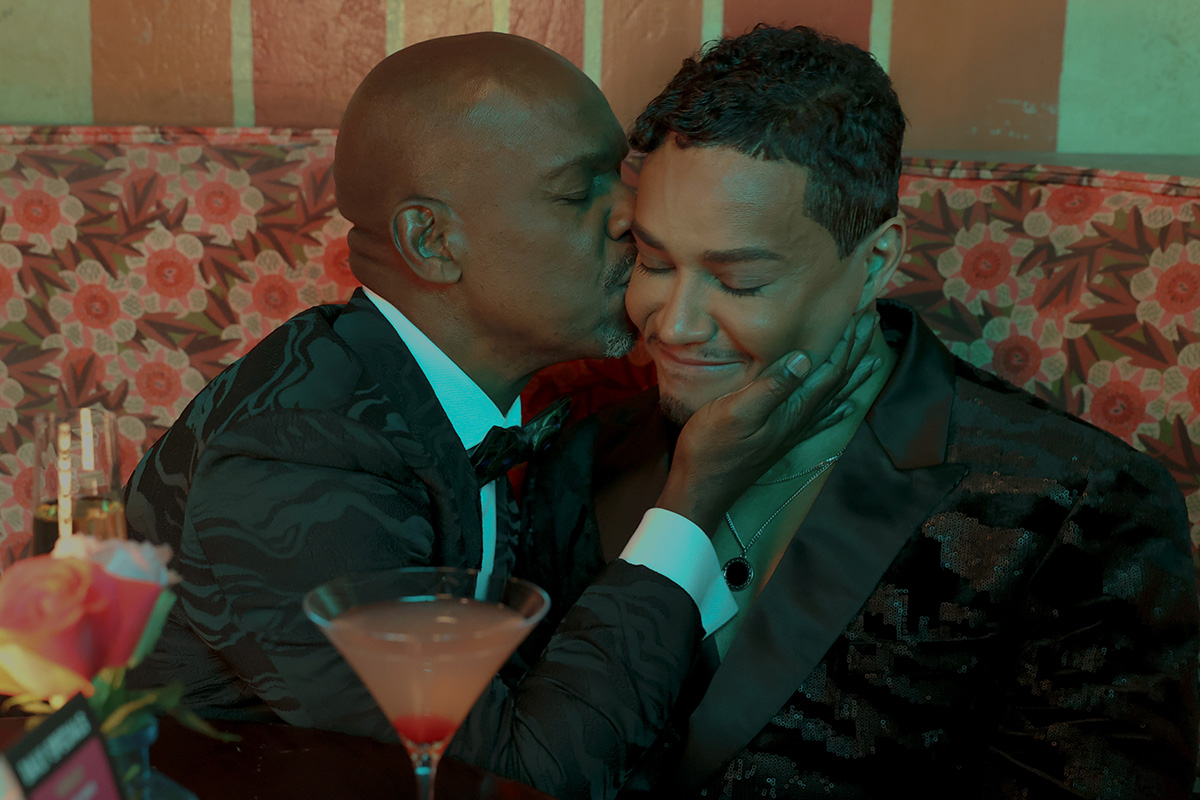
There’s no question that when Patrik-Ian Polk’s series “Noah’s Arc” premiered on Logo 20 years ago, it was a groundbreaking creation. The story of a group of Black gay men and their wonderful friendship. The titular arc was that of the cute main character, Noah (Darryl Stephens), and his close-knit circle of friends, including Chance played by gay actor Doug Spearman. This compelling and loving fraternity may, in fact, be what brought viewers back repeatedly, including a 2008 movie, “Noah’s Arc: Jumping the Broom,” as well as the 2020 “Noah’s Arc” short, and now, a new full-length feature “Noah’s Arc: The Movie,” debuting on Paramount+ on June 20. In the movie, filled with equal measures of laughs and tears, Chance, who has faced a devastating loss, finds his dependable friends there, ready to support and comfort him at a moment’s notice. I had the pleasure of speaking with Spearman the morning of the streaming premiere of “Noah’s Arc: The Movie.”
WASHINGTON BLADE: Doug, since the early 2000s, when the “Noah’s Arc” series premiered on Logo, you have been playing the character of Chance, including in the latest installment, “Noah’s Arc: The Movie.” What was it about Chance that appealed to you as an actor?
SPEARMAN: When Patrik (-Ian Polk) called me to ask me to play him (Chance), I was at JFK airport in the baggage claim, waiting for a suitcase. He explained what the part was. The thing that stuck out to me was the fact that Chance was in a long-term relationship with another Black man. And, they had a child; they had a 4-year-old daughter named Kenya. I had never seen two Black gay men raise a child on TV before. I thought it was the most revolutionary thing I’d ever seen. I immediately thought I’ve got to do this because that was something nobody had seen. I thought it was incredibly important to take the part.
BLADE: “Noah’s Arc: The Movie” was, once again, written and directed by Patrik-Ian Polk, who you just mentioned, is the creator of the entire franchise. What’s the secret to your long-standing working relationship?
SPEARMAN: [Laughs] the whole team, all of us, are like a band of brothers. We fight like brothers, we come together like brothers, we hash things out, we talk, because we’re all very different from our characters. I think the challenge of playing these guys and then uplifting these men, playing a part, especially something written by Patrik, is like solving a math equation. There’s always a challenge that’s enjoyable for me as an actor: to try to find out what it is that Patrik wants, and then how do I do it.
BLADE: I think you do a very good job of it.
SPEARMAN: Thank you very much
BLADE: In the years between “Jumping the Broom” and the new full-length movie, many changes have occurred, and the story addresses some of them, including gay widowhood, which is something that the aging community is now confronting, as well as mental health issues. Please say a few words about how you approached those subjects in the new movie.
SPEARMAN: I had a lot of loss in my life, right before we started shooting. Two months before we started shooting the first series, my mother died. I was going through the grief process through that whole first season. Since then, I’ve lost a lot of people in my life. In fact, when we started shooting the second season, the second week we were shooting, my ex died of a heart attack. I was having to fold that into what I was doing with my life on the set and off the set. You’ve got to show up and you’ve got to do your work. The first two seasons of “Noah’s Arc” are always tinged with the memory of grief. So, when I had to deal with the death that Chance faces (in the new movie), which is a significant death in his life, it wasn’t that hard to reach back, especially the scene in the graveyard. It was something that I unfortunately could pull from personal experience.
BLADE: Shifting gears, the movie features delightful cast surprises, including Jasmine Guy and TS Madison. Did you have a chance to interact with either or both when they were on set?
SPEARMAN: No, I didn’t have any scenes with Jasmine, and I missed her. I wish I had gotten to see her because I actually got to direct Jasmine for a CBS promo shoot for “Queen,” back in the early ‘90s. I had a huge crush on her when she was on “A Different World.” So, I really would have liked to reconnect. But TS and I got to see each other every day because I was in all her scenes. It was extraordinary being around somebody like that. That is one outspoken woman!
BLADE: Even though Beyoncé never makes an appearance in the movie, there’s a lot of talk about her. Would you say you are a Beyoncé fan?
SPEARMAN: Yes! I’m breathing! Yes, I’m a Beyoncé fan. I actually got the chance to meet her. I knew her mom. Her mom was extraordinary to me. She is in the second movie I directed. She also gave us a wedding gown to use in the very first scene of the movie. That family is extraordinarily important to me. Not only just to be a fan, but to be somebody who’s gotten to know them and work with them and see how hard they work. I don’t think anybody works as hard as Tina or Beyoncé.
BLADE: There was a recent news item about gay actor Benito Skinner of the Amazon Prime series “Overcompensating” being told not to bother auditioning for straight roles. As an out actor yourself, how important do you think it is for queer characters to be portrayed by queer actors, and vice versa?
SPEARMAN: Being queer is a multifaceted identity. There’s no one kind of queer person. I think finding the best actor that’s your first circle of casting. I think one of the joys about being an actor is that you get to play different parts. I play straight guys all the time. Dads and husbands and things like that. I think a lot of people are told not to do it. In fact, I wouldn’t be Chance if the actor who was originally cast as Chance hadn’t been pulled out of the series by his agents because they didn’t want him to play a gay character.
BLADE: That’s amazing! Thank you for sharing that. Without giving away too much, the ending of the movie is a little ambiguous, even ending with a question mark. If there was a “Noah’s Arc: The Movie” sequel, would you come back for that?
SPEARMAN: Yeah! A lot of it would depend on what Chance’s journey is going to be like. Patrik and I have conversations like that all the time. He’s very interested and supportive of input. I hope I would be, as we all would be, part of the creative growth with these characters. They live in Patrik’s head, and he writes them, but we’re the ones who have to flesh them out. It’s a conversation, it’s always a conversation.
BLADE: You are currently performing in Molière’s “The Imaginary Invalid” as part of the New Orleans Shakespeare Festival at Tulane. What has this experience been like for you?
SPEARMAN: It’s extraordinary! I started on stage when I was seven. There’s nothing like working with a live audience and having that immediacy. I’m working with an extraordinarily talented cast in a really great play, and I have some of the best scene partners I could ever want.
BLADE: Are there any upcoming film or TV projects you’d like to mention?
SPEARMAN: I’m still a writer, and I’m still a director, and I’ve still got scripts that I would like to make. I have a little something that’s a cross between “Treme” and “Bridgerton” that I want to do. I’m always trying to figure out what the next thing is.
a&e features
Visit Cambridge, a ‘beautiful secret’ on Maryland’s Eastern Shore
New organization promotes town’s welcoming vibe, LGBTQ inclusion
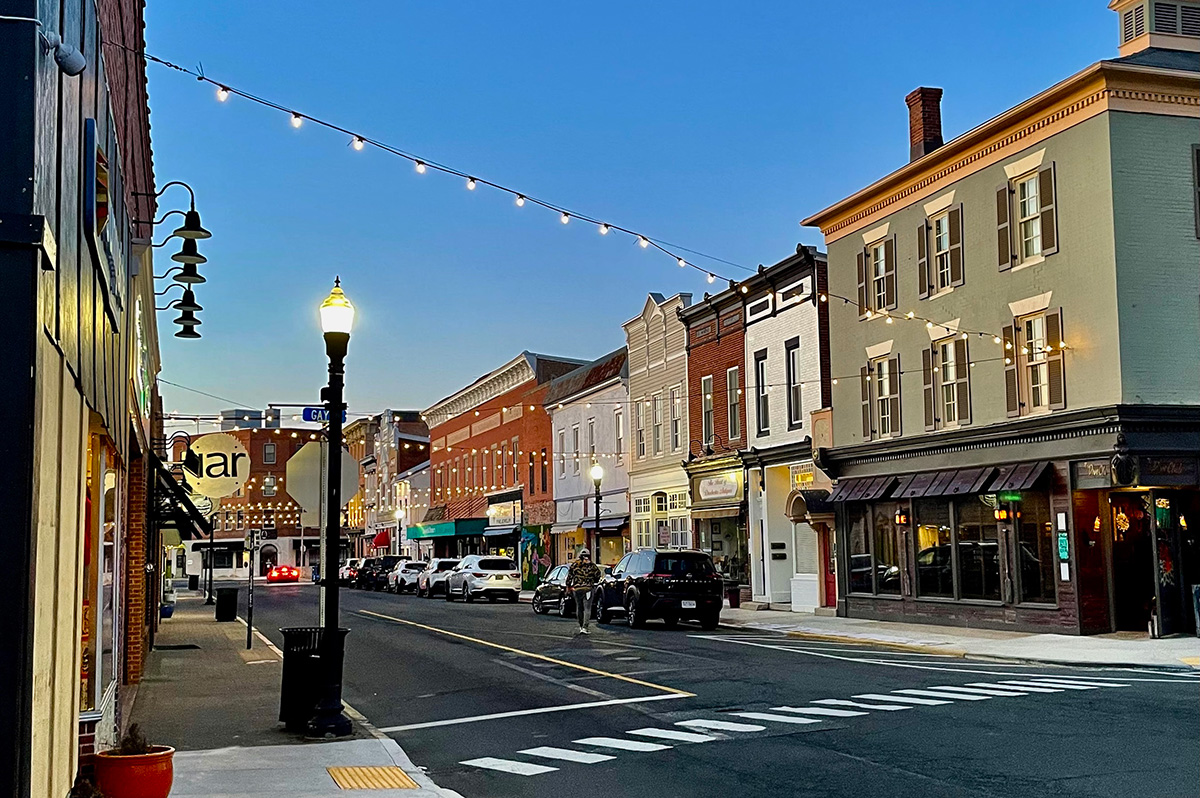
CAMBRIDGE, Md. — Driving through this scenic, historic town on Maryland’s Eastern Shore, you’ll be charmed by streets lined with unique shops, restaurants, and beautifully restored Victorian homes. You’ll also be struck by the number of LGBTQ Pride flags flying throughout the town.
The flags are a reassuring signal that everyone is welcome here, despite the town’s location in ruby red Dorchester County, which voted for Donald Trump over Kamala Harris by a lopsided margin. But don’t let that deter you from visiting. A new organization, Proudly Cambridge, is holding its debut Pride event this weekend, touting the town’s welcoming, inclusive culture.
“We stumbled on a beautiful secret and we wanted to help get the word out,” said James Lumalcuri of the effort to create Proudly Cambridge.
The organization celebrates diversity, enhances public spaces, and seeks to uplift all that Cambridge has to share, according to its mission statement, under the tagline “You Belong Here.”
The group has so far held informal movie nights and a picnic and garden party; the launch party is June 28 at the Cambridge Yacht Club, which will feature a Pride celebration and tea dance. The event’s 75 tickets sold out quickly and proceeds benefit DoCo Pride.
“Tickets went faster than we imagined and we’re bummed we can’t welcome everyone who wanted to come,” Lumalcuri said, adding that organizers plan to make “Cheers on the Choptank” an annual event with added capacity next year.
One of the group’s first projects was to distribute free Pride flags to anyone who requested one and the result is a visually striking display of a large number of flags flying all over town. Up next: Proudly Cambridge plans to roll out a program offering affirming businesses rainbow crab stickers to show their inclusiveness and LGBTQ support. The group also wants to engage with potential visitors and homebuyers.
“We want to spread the word outside of Cambridge — in D.C. and Baltimore — who don’t know about Cambridge,” Lumalcuri said. “We want them to come and know we are a safe haven. You can exist here and feel comfortable and supported by neighbors in a way that we didn’t anticipate when we moved here.”
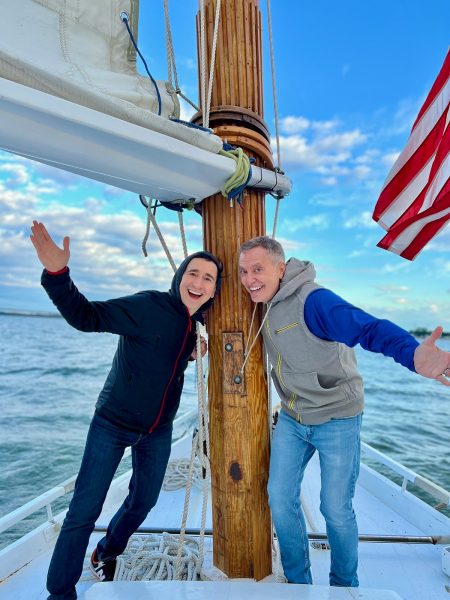
Lumalcuri, 53, a federal government employee, and his husband, Lou Cardenas, 62, a Realtor, purchased a Victorian house in Cambridge in 2021 and embarked on an extensive renovation. The couple also owns a home in Adams Morgan in D.C.
“We saw the opportunity here and wanted to share it with others,” Cardenas said. “There’s lots of housing inventory in the $300-400,000 range … we’re not here to gentrify people out of town because a lot of these homes are just empty and need to be fixed up and we’re happy to be a part of that.”
Lumalcuri was talking with friends one Sunday last year at the gazebo (affectionately known as the “gayzebo” by locals) at the Yacht Club and the idea for Proudly Cambridge was born. The founding board members are Lumalcuri, Corey van Vlymen, Brian Orjuela, Lauren Mross, and Caleb Holland. The group is currently working toward forming a 501(c)3.
“We need visibility and support for those who need it,” Mross said. “We started making lists of what we wanted to do and the five of us ran with it. We started meeting weekly and solidified what we wanted to do.”
Mross, 50, a brand strategist and web designer, moved to Cambridge from Atlanta with her wife three years ago. They knew they wanted to be near the water and farther north and began researching their options when they discovered Cambridge.
“I had not heard of Cambridge but the location seemed perfect,” she said. “I pointed on a map and said this is where we’re going to move.”
The couple packed up, bought a camper trailer and parked it in different campsites but kept coming back to Cambridge.
“I didn’t know how right it was until we moved here,” she said. “It’s the most welcoming place … there’s an energy vortex here – how did so many cool, progressive people end up in one place?”
Corey van Vlymen and his husband live in D.C. and were looking for a second home. They considered Lost River, W.Va., but decided they preferred to be on the water.
“We looked at a map on both sides of the bay and came to Cambridge on a Saturday and bought a house that day,” said van Vlymen, 39, a senior scientist at Booz Allen Hamilton. They’ve owned in Cambridge for two years.
They were drawn to Cambridge due to its location on the water, the affordable housing inventory, and its proximity to D.C.; it’s about an hour and 20 minutes away.
Now, through the work of Proudly Cambridge, they hope to highlight the town’s many attributes to residents and visitors alike.
“Something we all agree on is there’s a perception problem for Cambridge and a lack of awareness,” van Vlymen said. “If you tell someone you’re going to Cambridge, chances are they think, ‘England or Massachusetts?’”
He cited the affordability and the opportunity to save older, historic homes as a big draw for buyers.
“It’s all about celebrating all the things that make Cambridge great,” Mross added. “Our monthly social events are joyful and celebratory.” A recent game night drew about 70 people.
She noted that the goal is not to gentrify the town and push longtime residents out, but to uplift all the people who are already there while welcoming new visitors and future residents.
They also noted that Proudly Cambridge does not seek to supplant existing Pride-focused organizations. Dorchester County Pride organizes countywide Pride events and Delmarva Pride was held in nearby Easton two weeks ago.
“We celebrate all diversity but are gay powered and gay led,” Mross noted.
To learn more about Proudly Cambridge, visit the group on Facebook and Instagram.
What to see and do
Cambridge, located 13 miles up the Choptank River from the Chesapeake Bay, has a population of roughly 15,000. It was settled in 1684 and named for the English university town in 1686. It is home to the Harriet Tubman Museum, mural, and monument. Its proximity to the Blackwater National Wildlife Refuge makes it a popular stop for birders, drawn to more than 27,000 acres of marshland dubbed “the Everglades of the north.”
The refuge is walkable, bikeable, and driveable, making it an accessible attraction for all. There are kayaking and biking tours through Blackwater Adventures (blackwateradventuresmd.com).
Back in town, take a stroll along the water and through historic downtown and admire the architecture. Take in the striking Harriet Tubman mural (424 Race St.). Shop in the many local boutiques, and don’t miss the gay-owned Shorelife Home and Gifts (421 Race St.), filled with stylish coastal décor items.
Stop for breakfast or lunch at Black Water Bakery (429 Race St.), which offers a full compliment of coffee drinks along with a build-your-own mimosa bar and a full menu of creative cocktails.
The Cambridge Yacht Club (1 Mill St.) is always bustling but you need to be a member to get in. Snapper’s on the water is temporarily closed for renovations. RaR Brewing (rarbrewing.com) is popular for craft beers served in an 80-year-old former pool hall and bowling alley. The menu offers burgers, wings, and other bar fare.
For dinner or wine, don’t miss the fantastic Vintage 414 (414 Race St.), which offers lunch, dinner, wine tasting events, specialty foods, and a large selection of wines. The homemade cheddar crackers, inventive flatbreads, and creative desserts (citrus olive oil cake, carrot cake trifle) were a hit on a recent visit.
Also nearby is Ava’s (305 High St.), a regional chain offering outstanding Italian dishes, pizzas, and more.
For something off the beaten path, visit Emily’s Produce (22143 Church Creek Rd.) for its nursery, produce, and prepared meals.
“Ten minutes into the sticks there’s a place called Emily’s Produce, where you can pay $5 and walk through a field and pick sunflowers, blueberries, you can feed the goats … and they have great food,” van Vlymen said.
As for accommodations, there’s the Hyatt Regency Chesapeake Bay (100 Heron Blvd. at Route 50), a resort complex with golf course, spa, and marina. Otherwise, check out Airbnb and VRBO for short-term rentals closer to downtown.
Its proximity to D.C. and Baltimore makes Cambridge an ideal weekend getaway. The large LGBTQ population is welcoming and they are happy to talk up their town and show you around.
“There’s a closeness among the neighbors that I wasn’t feeling in D.C.,” Lumalcuri said. “We look after each other.”
-
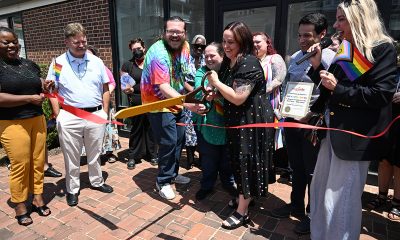
 Virginia2 days ago
Virginia2 days agoDefying trends, new LGBTQ center opens in rural Winchester, Va.
-
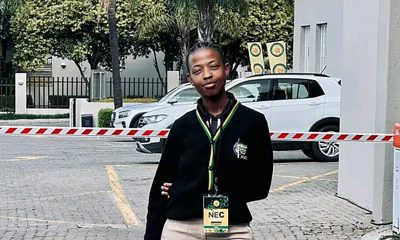
 South Africa4 days ago
South Africa4 days agoLesbian feminist becomes South African MP
-
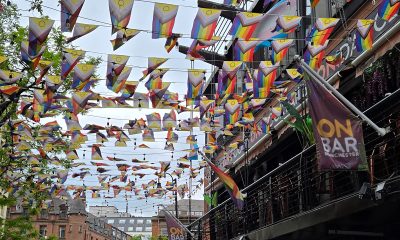
 Travel3 days ago
Travel3 days agoManchester is vibrant tapestry of culture, history, and Pride
-
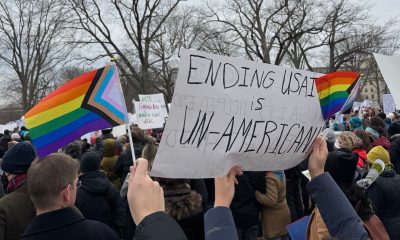
 Opinions3 days ago
Opinions3 days agoUSAID’s demise: America’s global betrayal of trust with LGBTQ people

